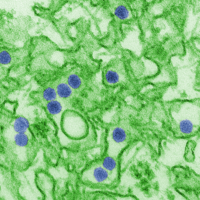
Photo from wikipedia
Zika virus (ZIKV) is an emerging mosquito-borne flavivirus that has attracted global attention and international awareness. ZIKV infection exhibits mild symptoms including fever and pains; however, ZIKV has recently been… Click to show full abstract
Zika virus (ZIKV) is an emerging mosquito-borne flavivirus that has attracted global attention and international awareness. ZIKV infection exhibits mild symptoms including fever and pains; however, ZIKV has recently been shown to be related to increased birth defects, including microcephaly, in infants. In addition, ZIKV is related to the onset of neurological disorders, such as a type of paralysis similar to Guillain-Barré syndrome. However, the mechanisms through which ZIKV affect neuronal cells and myeloid dendritic cells and how ZIKV avoids host immunity are unclear. Accordingly, in this study, we analyzed RNA sequencing data from ZIKV-infected neuronal cells and myeloid dendritic cells by comparative network analyses using protein-protein interaction information. Comparative network analysis revealed major genes showing differential changes in the peripheral neurons, neural crest cells, and myeloid dendritic cells after ZIKV infection. The genes were related to DNA repair systems and prolactin signaling as well as the interferon signaling, neuroinflammation, and cell cycle pathways. These pathways were interconnected by the interaction of proteins in the pathway and significantly regulated by ZIKV infection in neuronal cells and myeloid dendritic cells. Our analysis showed that neuronal cell damage occurred through up-regulation of neuroinflammation and down-regulation of the DNA repair system, but not in myeloid dendritic cells. Interestingly, immune escape by ZIKV infection could be caused by downregulation of prolactin signaling including IRS2, PIK3C3, JAK3, STAT3, and IRF1 as well as mitochondria dysfunction and oxidative phosphorylation in myeloid dendritic cells. These findings provide insight into the mechanisms of ZIKV infection in the host and the association of ZIKV with neurological and immunological symptoms, which may facilitate the development of therapeutic agents and vaccines.
Journal Title: PLoS ONE
Year Published: 2020
Link to full text (if available)
Share on Social Media: Sign Up to like & get
recommendations!